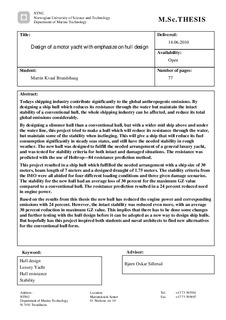| dc.description.abstract | This thesis consists of two integrated parts. The main attempt is to design and test a new hull which will reduce the total water resistance and need for engine power, but maintains the stability of a conventional hull. To see if the hull is sufficient enough for a general luxury yacht, there will also be a need for an arrangement design process for the calculation of the needed volume and equipment.
Based on external conditions the main parameters for the yacht was set. This resulted in a 30 meter long yacht, with a draught of 1.75 meters and a beam length of 7 meters. The yacht has a fuel capacity of 18 tons and a fresh water capacity of 4000 liters. Regarding accommodation and facilities it has 5 bed rooms, 5 bath rooms, kitchen, restaurant and a room for a small boat. The yacht is equipped with watertight bulkheads to prevent flooding of the complete ship, and floating devices to prevent sinking if the ship should be completely flooded. The yacht will in total have a lightweight of 191 tons and a deadweight at departure of 26 tons.
The idea for the new hull is to have a more slender hull than a conventional hull, but maintain the volume in the midship under and over the water surface. This will, in theory, give reduced water resistance because of the reduced waterline beam length. However, when inclining the increase in waterline area will maintain some of the stability. To be able to compare the results it was also modeled a conventional hull for this thesis. This comparison hull has the same main parameters as the new hull, but designed with a conventional midship with long flat sides.
The two different hulls were given four loading conditions. The first loading condition had 100 % fuel, fresh water and food supply. The second one had 10 %, and the third one had 50 %. The last loading condition had 100 % fuel, fresh water and food supply and no use of the water ballast tanks. The intact stability was tested for each loading condition and checked up against the IMO criteria for passenger and cargo vessels of all sizes. The calculations showed that the general stability was weakened with 30 percent for the new type of hull, but the increased stability was noticed at 5-10° heeling angle because of the larger waterline area.
The new hull with an initial loading condition consisting of 100 % fuel, fresh water and food supply was then tested for three given damage scenarios. In scenario 1 the water entry started on the port side in the fore part of the ship, simulating a crash while coming along the quay. Scenario 2 simulated a front crash, resulting in flooding of the two front water ballast tanks and the chain room. The last scenario simulated a run aground of the ocean floor, resulting in flooding of three water ballast tanks and the fresh water tank. Damage scenario 1 resulted in a heel angle of 21° and the water level reaching 7 centimeters above the hull height. As a consequence of this there must be installed one or two more water tight walls, bulkheads, in the two corridors at this deck.
The resistance of the two hulls was predicted with the Holtrop-84 resistance prediction method. Holtrop has implemented statistical results from several model tests in a formula which calculates the ship resistance based on some of the main parameters of the hull form. Based on the results from this test the new hull required 24 % less engine power than the conventional hull. This can save fuel for over 72 000 US$ per year.
The new hull design has both its advantages and disadvantages, but much research remains before it can be either refused or accepted as a new way to design ship hulls. The stability and resistance can in general not be compared, but the calculations show a larger reduction of the stability than for the resistance, which implies that both changes and more testing must be executed before the new hull can be introduced to the yacht market. | nb_NO |
